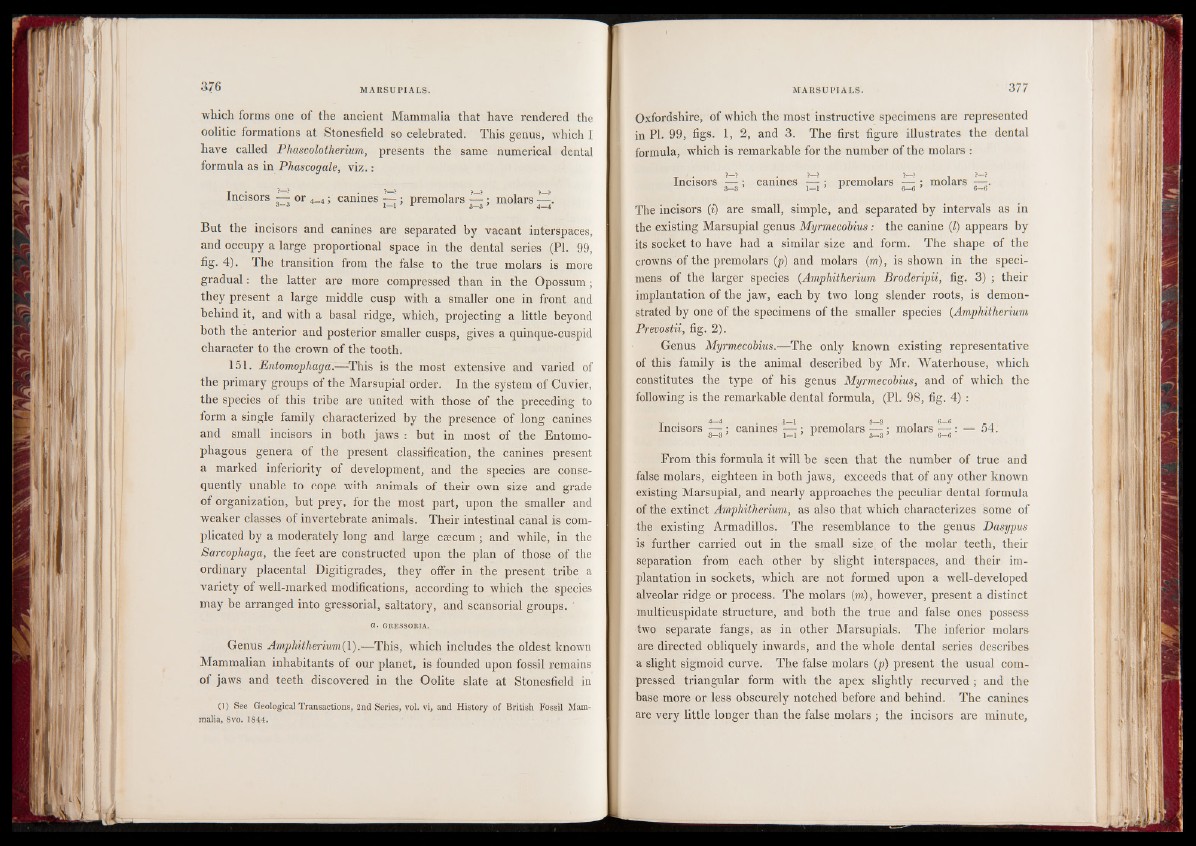
which forms one of the ancient Mammalia that have rendered the
oolitic formations at Stonesfield so celebrated. This genus, which I
have called Phascolotherium, presents the same numerical dental
formula as in Phascogale, viz. :
Incisors — or 4-4 ; canines — ; premolars — ; molars —.
But the incisors and canines are separated by vacant interspaces,
and occupy a large proportional space in the dental series (PI. 99,
fig. 4). The transition from the false to the true molars is more
gradual : the latter are more compressed than in the Opossum ;
they present a large middle cusp with a smaller one in front and
behind it, and with a basal ridge, which, projecting a little beyond
both the anterior and posterior smaller cusps, gives a quinque-cuspid
character to the crown of the tooth.
151. Entomophaga.—This is the most extensive and varied of
the primary groups of the Marsupial order. In the system of Cuvier,
the species of this tribe are united with those of the preceding to
form a single family characterized by the presence of long canines
and small incisors in both jaws : but in most of the Entomo-
phagous genera of the present classification, the canines present
a marked inferiority of development, and the species are consequently
unable to cope with animals of their own size and grade
of organization, but prey, for the most part, upon the smaller and
weaker classes of invertebrate animals. Their intestinal canal is complicated
by a moderately long and large cæcum ; and while, in the
Sarcophaga, the feet are constructed upon the plan of those of the
ordinary placental Digitigrades, they offer in the present tribe a
variety of well-marked modifications, according to which the species
may be arranged into gressorial, saltatory, and scansorial groups. '
a* GRESSORIA.
Genus AmphitheriumiY).—This, which includes the oldest known
Mammalian inhabitants of our planet, is founded upon fossil remains
of jaws and teeth discovered in the Oolite slate at Stonesfield in
(1) See Geological Transactions, 2nd Series, vol. vi, and History of British Fossil Mammalia,
8vo. 1844.
Oxfordshire, of which the most instructive specimens are represented
in PI- 99, figs. 1, 2, and 3. The first figure illustrates the dental
formula, which is remarkable for the number of the molars :
Incisors — ; canines — : premolars — : molars
The incisors (i) are small, simple, and separated by intervals as in
the existing Marsupial genus Myrmecobius: the canine (l) appears by
its socket to have had a similar size and form. The shape of the
crowns of the premolars (p) and molars (m), is shown in the specimens
of the larger species (Amphitherium Broderipii, fig. 3) ; their
implantation of the jaw, each by two long slender roots, is demonstrated
by one of the specimens of the smaller species (Amphitherium,
Prevostii, fig. 2).
Genus Myrmecobius.r-^-The only known existing representative
of this family is the animal described by Mr. Waterhouse, which
constitutes the type of his genus Myrmecobius, and of which the
following is the remarkable dental formula, (PI. 98, fig. 4) :
T 4—4 . ,1—Incisors — :c anines — 1: premolars , 3——3 .: m ola,r s -S6H—I6 == 5_ 4g. 3—3 3 1—1 3 r 3—3 3 6—6
From this formula it will be seen that the number of true and
false molars, eighteen in both jaws, exceeds that of any other known
existing Marsupial, and nearly approaches the peculiar dental formula
of the extinct Amphitherium, as also that which characterizes some of
the existing Armadillos. The resemblance to the genus Dasypus
is further carried out in the small size, of the molar teeth, their
separation from each other by slight interspaces, and their implantation.
in sockets, which are not formed upon a well-developed
alveolar ridge or process. The molars (m), however, present a distinct
multicuspidate structure, and both the true and false ones possess
two separate fangs, as in other Marsupials. The inferior molars
are directed obliquely inwards, and the whole dental series describes
a slight sigmoid curve. The false molars (p) present the usual compressed
triangular form with the apex slightly recurved ; and the
base more or less obscurely notched before and behind. The canines
are very little longer than the false molars ; the incisors are minute,